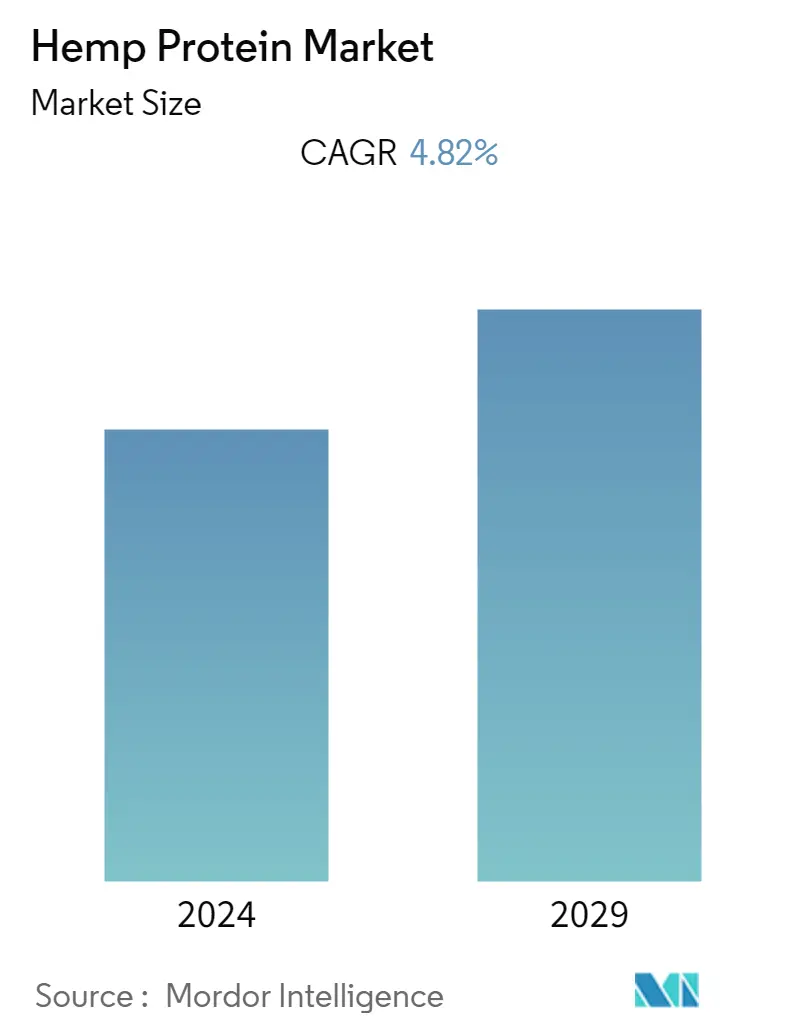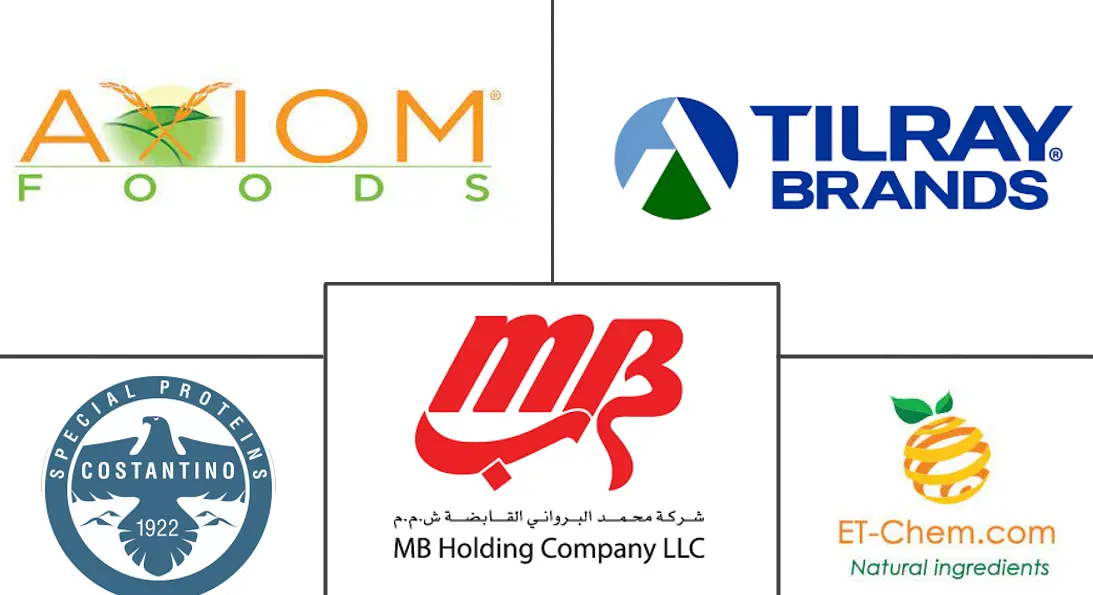Market Size of Hemp Protein Industry

| Study Period | 2019 - 2029 |
| Base Year For Estimation | 2023 |
| CAGR | 4.82 % |
| Fastest Growing Market | Europe |
| Largest Market | North America |
| Market Concentration | Low |
Major Players
*Disclaimer: Major Players sorted in no particular order |
Hemp Protein Market Analysis
The hemp protein market size is expected to grow from USD 65.71 million in 2023 to USD 83.15 million by 2028, at a CAGR of 4.82% during the forecast period.
- Hemp proteins are easily digestible and are used as an active ingredient in various industry applications, including food and beverages, pharmaceuticals, personal care, and other industries. Additionally, the health benefits of hemp proteins, including anti-fatigue properties, enhancement of the immune system, and protective effects for the kidney, are attracting consumers to include hemp protein-based foods in their diets, which is eventually raising the industrial usage of hemp protein.
- Similarly, the growth of the hemp protein market is also being propelled by improved economic conditions, coupled with an increase in household wealth, due to which consumers have shown a willingness to spend on food products that are rich in hemp proteins to maintain their health.
- Moreover, plant-based bakery consumption is on a consistent rise and is estimated to be growing year-on-year. The trend is considered to be a typical offshoot of all-natural and clean-label eating shifts observed among consumers. This, on the other hand, is paving the way for potential ingredients that have been untapped by the market.
- In line with this, hemp protein often falls under the clean protein plant-based source that allows products to be made with organic and non-GMO ingredients and free from artificial sweeteners, colors, and preservatives. Hemp is naturally gluten-free, non-GMO, free of trypsin inhibitors, and virtually free of any form of residual chemicals. In addition, the hemp protein in the powdered form witnesses high demand as compared to the liquid form due to its increased shelf life, convenience, and other associated factors.
- Furthermore, the emerging trend of veganism has also helped in boosting the revenue of the market. Factors like minimally processed and chemical-free vegan food consumption patterns have also opened up opportunities for the market, allowing players to innovate and develop ingredients with multiple application capabilities.
- For instance, according to the Institute for Demoscopy Allensbach (IfD), in 2022, about 7.9 million people in Germany were either vegetarians or largely forgo meat consumption. Since 2014, the number of people identifying as either complete or nearly complete vegetarians has grown by approximately 2.51 million individuals.
- Hence, key players are focused on investing in researching hemp seeds to make them a good source of proteins, which is further expected to drive the market's growth. Furthermore, expanding the use of hemp seed protein in several industries may offer key opportunities for growth in the global market.
Hemp Protein Industry Segmentation
The cannabis plant produces hemp protein, which is extracted from hemp seeds. The two highly digestible globular kinds of proteins, 2S albumin, and edestin, make up the protein in hemp seeds; edestin is particularly enriched in important amino acids.
The hemp protein market is segmented by source, application, and geography. By source, the market is segmented into organic and conventional. By application, the market is segmented into functional food, functional beverages, dietary supplements, pharmaceuticals, personal care, and other industrial uses. By geography, the market is segmented into North America, Europe, Asia-Pacific, South America, and the Middle East and Africa.
The market sizing has been done in value terms in USD and for volume terms in volume in tons for all the abovementioned segments.
| Source | |
| Organic | |
| Conventional |
| Application | |
| Functional Food | |
| Functional Beverage | |
| Dietary Supplements | |
| Pharmaceuticals | |
| Personal Care | |
| Other Industrial Uses |
| Geography | |||||||||
| |||||||||
| |||||||||
| |||||||||
| |||||||||
|
Hemp Protein Market Size Summary
The hemp protein market is experiencing a notable expansion, driven by its versatile applications across various industries such as food and beverages, pharmaceuticals, and personal care. The increasing consumer awareness of the health benefits associated with hemp protein, including its anti-fatigue properties and immune system enhancement, is significantly contributing to its rising popularity. This trend is further supported by the growing economic conditions and increased household wealth, which encourage consumers to invest in health-oriented food products. The shift towards plant-based diets, influenced by ecological concerns and health consciousness, is also propelling the demand for hemp protein as a clean and sustainable protein source. The market is witnessing a surge in the consumption of plant-based bakery products, which aligns with the broader movement towards all-natural and clean-label eating habits.
In North America, the hemp protein market is particularly thriving due to the region's strong inclination towards plant-based proteins and heightened health and nutrition awareness. The demand for hemp protein is further bolstered by its compatibility with vegan and vegetarian diets, as well as its allergen-free and gluten-free properties. Companies are actively innovating and launching new hemp protein products to cater to the evolving consumer preferences, thereby expanding their market presence. The global market remains fragmented, with key players focusing on strategic expansions, acquisitions, and partnerships to enhance their market share. These efforts, coupled with the increasing consumer demand for organic and non-GMO ingredients, are expected to drive the continued growth of the hemp protein market in the coming years.
Hemp Protein Market Size - Table of Contents
-
1. MARKET DYNAMICS
-
1.1 Market Drivers
-
1.1.1 Rising Preference for Plant-Based Protein
-
1.1.2 Prevalence of Consumers Intolerant to Soy, Peanut and Other Legumes is Increasing
-
-
1.2 Market Restraints
-
1.2.1 Strict Regulation and Policies Pertaining to Hemp Protein
-
-
1.3 Porter's Five Forces Analysis
-
1.3.1 Threat of New Entrants
-
1.3.2 Bargaining Power of Buyers/Consumers
-
1.3.3 Bargaining Power of Suppliers
-
1.3.4 Threat of Substitute Products
-
1.3.5 Intensity of Competitive Rivalry
-
-
-
2. MARKET SEGMENTATION
-
2.1 Source
-
2.1.1 Organic
-
2.1.2 Conventional
-
-
2.2 Application
-
2.2.1 Functional Food
-
2.2.2 Functional Beverage
-
2.2.3 Dietary Supplements
-
2.2.4 Pharmaceuticals
-
2.2.5 Personal Care
-
2.2.6 Other Industrial Uses
-
-
2.3 Geography
-
2.3.1 North America
-
2.3.1.1 United States
-
2.3.1.2 Canada
-
2.3.1.3 Mexico
-
2.3.1.4 Rest of North America
-
-
2.3.2 Europe
-
2.3.2.1 Germany
-
2.3.2.2 United Kingdom
-
2.3.2.3 Italy
-
2.3.2.4 France
-
2.3.2.5 Russia
-
2.3.2.6 Spain
-
2.3.2.7 Rest of Europe
-
-
2.3.3 Asia Pacific
-
2.3.3.1 India
-
2.3.3.2 China
-
2.3.3.3 Japan
-
2.3.3.4 Australia
-
2.3.3.5 Rest of Asia Pacific
-
-
2.3.4 South America
-
2.3.4.1 Brazil
-
2.3.4.2 Argentina
-
2.3.4.3 Rest of South America
-
-
2.3.5 Middle East & Africa
-
2.3.5.1 Saudi Arabia
-
2.3.5.2 South Africa
-
2.3.5.3 Rest of Middle East & Africa
-
-
-
Hemp Protein Market Size FAQs
What is the current Hemp Protein Market size?
The Hemp Protein Market is projected to register a CAGR of 4.82% during the forecast period (2024-2029)
Who are the key players in Hemp Protein Market?
A. Costantino & C. spa, Axiom Foods, Inc., Tilray Brands, Inc., ETChem and MB-Holding GmbH & Co. KG are the major companies operating in the Hemp Protein Market.

